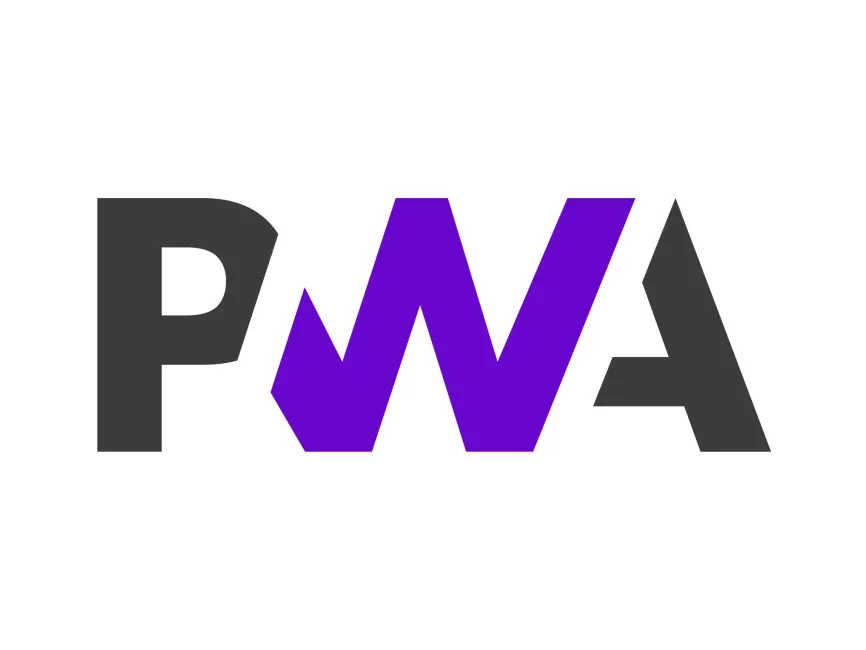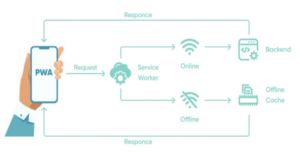
Progressive web apps: how can businesses leverage them?
In the evolving digital landscape, Progressive Web Apps (PWAs) have emerged as a powerful tool for businesses aiming to provide seamless user experiences and boost engagement. PWAs blend the best of web and mobile applications, offering capabilities that traditional websites lack while avoiding the complexities of developing separate mobile apps. In this article, we’ll explore what PWAs are, their benefits for business growth, and how AI can be integrated into their development.
What Are Progressive Web Apps?
A Progressive Web App (PWA) is a type of application software delivered through the web, built using common web technologies like HTML, CSS, and JavaScript. What sets PWAs apart is their ability to deliver an app-like experience on the web. Users can access a PWA through their browser without downloading it from an app store, yet they still enjoy features like push notifications, offline functionality, and faster load times.
Key Characteristics of a Progressive Web Application:
- Responsive Design: PWAs are designed to fit various screen sizes, from desktops to tablets and smartphones.
- Offline Accessibility: With service workers, PWAs can cache data, allowing users to access content even without an active internet connection.
- App-like Interface: PWAs offer a more immersive experience with a native-like interface, providing a similar user experience to mobile apps.
- Push Notifications: Businesses can send timely updates to users, enhancing re-engagement.
- Installable: PWAs can be “installed” to the user’s home screen, making them easily accessible without occupying much storage.

How Businesses Can Leverage PWAs for Growth
Progressive Web Apps (PWAs) offer numerous benefits for businesses looking to increase their digital reach, streamline customer interactions, and reduce costs. With features like fast load times, offline access, and push notifications, PWAs enable companies to enhance user experiences and drive more meaningful engagement. Let’s delve deeper into how businesses can leverage PWAs for growth and maximize their digital presence.
1. Improving Customer Engagement and Retention
PWAs enhance user engagement by providing a smooth, app-like experience directly through the web browser. Features like push notifications help businesses send timely updates, promotional offers, or reminders to users, even when they’re not actively browsing the site. This keeps users engaged and encourages repeat visits, which are crucial for customer retention and long-term loyalty.
For example, Alibaba increased its interaction rate by 4% after implementing a PWA, while Lancome’s PWA resulted in a 17% increase in conversions. These cases demonstrate that a well-designed PWA can significantly improve user interaction and retention by offering seamless and engaging experiences.
2. Increasing Reach with Cross-Platform Compatibility
One of the most significant advantages of PWAs is their cross-platform compatibility. They can function on any device or operating system, providing a uniform experience without the need for separate apps for Android, iOS, and the web. This enables businesses to reach a broader audience while keeping development and maintenance costs low.
For instance, Trivago adopted a PWA strategy to provide a consistent experience across devices, which led to a 150% increase in repeat visits and a 97% increase in click-outs to hotel offers. This case showcases how a PWA’s ability to reach users on multiple platforms can drive both engagement and conversions.
3. Reducing Development and Maintenance Costs
Developing separate native apps for multiple platforms can be time-consuming and costly. PWAs eliminate the need for multiple versions of an app, as a single PWA works seamlessly across various devices and browsers. This unified approach not only reduces initial development costs but also simplifies updates and maintenance, as changes only need to be applied once and are instantly reflected across all devices.
Moreover, businesses don’t have to pay app store fees or go through lengthy approval processes for updates, making it easier and faster to roll out new features or address issues. This agility can be a significant competitive advantage in fast-paced markets.
4. Boosting SEO and Organic Visibility
Since PWAs are indexed by search engines just like traditional websites, they contribute to a business’s SEO strategy. A well-optimized PWA can rank higher in search results, making it easier for potential customers to discover the business online. Additionally, PWAs load faster and provide a better user experience, which are crucial factors for search engine ranking.
By focusing on SEO-friendly keywords such as Progressive Web Apps, progressive web application, example of a progressive web app, and PWA, businesses can attract more organic traffic and generate more leads. An optimized PWA strategy not only improves visibility but also enhances the overall user experience, leading to higher engagement and conversion rates.
5. Leveraging AI for Personalization and Automation
Integrating AI into PWAs can take user engagement to the next level. AI-powered features like personalized recommendations, chatbots, and predictive analytics can provide tailored experiences that meet individual user preferences. For example, eCommerce PWAs can use AI to show users products they are more likely to purchase based on their browsing history and past interactions.
Furthermore, AI can automate routine processes like customer support or FAQ responses, freeing up valuable time for businesses to focus on strategic initiatives. This kind of automation not only improves efficiency but also enhances user satisfaction by providing immediate, round-the-clock support.
6. Enhancing Offline Capabilities and User Experience
One of the standout features of a PWA is its offline capability. Using service workers, a PWA can cache data and allow users to browse content even when they are not connected to the internet. This is especially useful for businesses in regions with unstable internet connectivity or for users on the go.
For example, a travel site could enable users to check previously viewed hotels or trip itineraries without an internet connection. By providing uninterrupted access to essential information, businesses can ensure a positive user experience that keeps customers engaged even when they are offline.
7. Facilitating Rapid Market Expansion
For businesses looking to expand into new markets, PWAs can be an ideal solution. Because they do not require installation from an app store and can be accessed directly through a browser, PWAs are more accessible to users. This can be particularly beneficial in emerging markets where users may have limited storage space on their devices or face challenges with internet connectivity.
By adopting a PWA, businesses can lower the entry barriers for new users, making it easier to gain traction in new markets. The ability to deliver a native-like experience without requiring a traditional app download can help attract a larger user base and drive growth in previously untapped regions.
Examples of Successful Progressive Web Apps
Several companies have embraced PWAs with great success. Here are a few notable examples:
- Starbucks: The coffee giant’s PWA allows users to browse the menu and customize orders offline, significantly enhancing customer convenience.
- Pinterest: Pinterest’s PWA led to a 60% increase in core engagements and a 40% increase in time spent on the site, highlighting its power to re-engage users.
- Twitter Lite: Twitter’s PWA reduced data usage by 70% while increasing engagement rates, thanks to the app’s faster load times and offline functionality.
How AI Fits into PWA Development
Artificial Intelligence (AI) is revolutionizing the way PWAs are developed and how they interact with users. Integrating AI can enhance the functionality and user experience of a PWA in various ways:
- Personalization: AI can analyze user behavior to offer personalized recommendations, content, and services within a PWA. For instance, an eCommerce PWA can show product suggestions based on the user’s past browsing history and preferences. AI can not only be used for user experience but building out the actual PWA. See how AI impacts Web Development.
- Chatbots and Virtual Assistants: Incorporating AI-powered chatbots into PWAs allows businesses to offer instant customer support, improving user satisfaction. These bots can answer frequently asked questions, guide users through the purchasing process, and even assist with troubleshooting.
- Predictive Analysis: AI algorithms can predict user behavior and suggest proactive measures, such as notifying customers about restocks or sales based on their past interactions. This predictive capability helps businesses drive more targeted engagement.
- Enhanced Security: AI can monitor traffic and user interactions to identify any unusual activities or potential security threats in real-time, ensuring the PWA remains secure for all users.
Key Takeaways:
- PWAs blend the benefits of websites and mobile apps, providing faster load times, offline capabilities, and an app-like interface.
- Businesses can use PWAs to improve user experience, enhance engagement, and save on development costs.
- Integrating AI into PWAs can further elevate user experience through personalization, chatbots, and predictive analysis.
By investing in progressive web applications, companies can create a future-proof strategy that caters to the growing demands of today’s tech-savvy consumers.
Conclusion
Progressive Web Apps are more than just a technological trend; they represent a paradigm shift in how businesses can deliver digital experiences. By offering the best of both web and mobile, PWAs can help businesses reach broader audiences, engage users more effectively, and reduce development costs. Coupled with AI, PWAs can provide highly personalized, interactive, and secure experiences that drive business growth and customer satisfaction.
Adopting a PWA strategy can be a game-changer, whether for eCommerce, content publishing, or service-based industries. With the ability to engage users on multiple platforms, PWAs are set to become a cornerstone of the modern digital experience.



